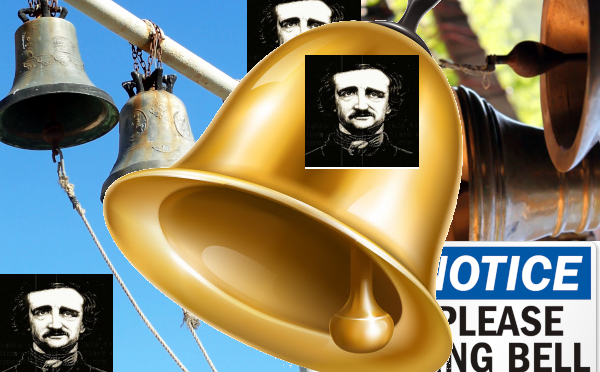BELLS bells BELLS
ow To Ring Up A Church Bell
Created Aug 20, 2002 | Updated Oct 15, 2012
One of the hardest things that Change Ringers have to do in order to ring Church Bells is to ring them up, that is, to get them from the hanging 'down' position, to the ready 'up' position which the bells stay in between ringing different methods or patterns. Bells in the 'up' position resemble a cup which is stood in the normal manner, with the rim upwards. Bells that are 'up' are effectively resting against a point which is just over the balance. Therefore when they need to be rung again, the bellringer needs only to pull off the bell from the stay on which it is resting and it will begin to fall and swing under its own momentum.
I.
Hear the sledges with the bells—
Silver bells!
What a world of merriment their melody foretells!
How they tinkle, tinkle, tinkle,
In the icy air of night!
While the stars that oversprinkle
To get the bells into this resting position in the first place requires a lot of skill. Especially if the ringers want to keep all six, eight or even twelve bells ringing in rounds continuously while they are doing this, which will sound like a descending scale, and at the same time swinging them higher and higher until they can safely be rested on the stay.
To begin, hold the rope as if you are ringing normally, right handed people will hold the right hand further up the rope than the left hand with the thumb on top, and both hands touching each other. Then the ringer will check that the bell is definately 'down', by attempting to pull the bell off as if it is 'up'. If it is, the ringer can safely ring normally then ring down so that they are ready to ring up again. If the bell is in fact 'down', it will simply swing where it is and the rope will stay put.
All the heavens, seem to twinkle
With a crystalline delight;
Keeping time, time, time,
In a sort of Runic rhyme,
To the tintinabulation that so musically wells
From the bells, bells, bells, bells,
Bells, bells, bells—
From the jingling and the tinkling of the bells.
Now that you know the bell is most definately down, you can make your coils. Three is the usual number, but it will depend on your height, your rope, your style and the weight of your bell, just make sure the coils are comfortable. They should be made so that you still hold the rope and the gathered coils in the same way you hold the rope normally, the coils should be placed in the crook of your thumb of your left hand, and your right hand (for right-handed persons) should still be touching and on top.
Okay, you have made your coils, and you have grabbed the Sally (the fluffy bit of the rope, usually red, blue and white). You are looking (in most cases) to your right, ready to go. The conductor calls 'Go!' You must begin to swing almost immediately after the bell before you has pulled theirs. This is the important part in which to make sure your bell does not go up 'wrong' and the clapper begins to hit the wrong side of the bell as it rises. You must pull pretty hard each swing and make sure the bell sounds each time the Sally gets to the top by checking it quite sharply. While you are doing this, keep a close watch on the bell you are following, and keep your hands in relatively the same position on the rope as theirs. You should start making the gaps slightly bigger from this point onwards. As the Sally begins to get too high for your reach, slide your hands down the rope into the first coil and when the coil of rope is tight around your left hand, let it go.
II.
Hear the mellow wedding bells,
Golden bells!
What a world of happiness their harmony foretells!
Through the balmy air of night
How they ring out their delight!
From the molten-golden notes,
And all in tune,
What a liquid ditty floats
To the turtle-dove that listens, while she gloats
On the moon!
Oh, from out the sounding cells,
What a gush of euphony voluminously wells!
How it swells!
How it dwells
On the Future! how it tells
To let go of a coil, always do it when your hands are at the lowest point. All you have to do is lift the thumb of your left hand and twist your wrist so that the rope is released over the top of your hand. It is a simple, quick movement which is easy once you can do it.
Of the rapture that impels
To the swinging and the ringing
Of the bells, bells, bells,
Of the bells, bells, bells, bells,
Bells, bells, bells—
To the rhyming and the chiming of the bells!
III.
This is when it starts to get tricky and can go wrong if you're not careful. Keep an eye on the bell you are following. Does your bell sound immediately after it? Are you at about the same stage in the process? Are you still pulling quite quickly after it? Is the gap even? If so then keep pulling and getting the bell higher. Do not let dropping the first coil put your action out of synch with everyone else. Always keep listening, you will be able to tell when something is amiss when it just doesn't sound right. See if you can hear which bell is yours and if it is in the right place with an even gap.
Hear the loud alarum bells—
Brazen bells!
What tale of terror, now, their turbulency tells!
In the startled ear of night
How they scream out their affright!
Too much horrified to speak,
They can only shriek, shriek,
Out of tune,
When the Sally starts to bob when it is at its lowest point, this is when the real hand stoke is forming. Your right hand should be used to guide it, but never to pull it at this stage as the action of the handstroke is too small and it will shoot up really quickly. You should still be keeping in the right place with the backstroke, not the handstroke, so make sure that when you pull the rope from the backstoke (when your hands are highest), that you are pulling in the right place, after the bell you are following, and continue to widen the gap between you and them. With your right hand you can start to pull the Sally a very small amount, more and more each time so that the bell goes up, and do not forget that at about this point you will need to lose your next coil so that you either have one or two left. (Never have loads of flapping rope beneath your hands, it is dangerous and can hurt when slapping you in the face). A common mistake when losing this coil is to forget to pull the handstroke again, as you drop the coil when your hands are at the lowest point, then you immediately have to catch the rising sally for handstroke.
In a clamorous appealing to the mercy of the fire,
In a mad expostulation with the deaf and frantic fire,
Leaping higher, higher, higher,
With a desperate desire,
And a resolute endeavor
Now—now to sit or never,
By the side of the pale-faced moon.
Oh, the bells, bells, bells!
What a tale their terror tells
Of Despair!
If you are still in the right place, keep going, pulling both strokes more and more, each time inching your hands down the rope and staying in the right place, until you can drop the last coil. The sally will now be more easy to control, and what you are ringing will feel more like a normal action. As you drop your last coil, don't forget to keep pulling, the bell is almost up but not quite, and after a few more strokes you can start catching the Sally with both hands like normal. Your gaps should be close to the normal space that you leave when ringing.
It is easy to get into proper rounds from here and stand the bell when the conductor shouts 'Stand!', or to begin ringing a method if that is the plan.
That is the theory, now all you need to do is practise it, or join a local tower if you are not a
How they clang, and clash, and roar!
What a horror they outpour
On the bosom of the palpitating air!
Yet the ear it fully knows,
By the twanging,
And the clanging,
Once gained, bell ringing is a skill for life you’ll never forget and can open up a lifetime of experiences and enjoyment.
New ringers follow the ‘Learning the Ropes’ programme to learn to ring, taught by accredited instructors through the Association of Ringing Teachers. There are five stages from beginner to experienced ringer and at all stages you’re helped out by either a personal tutor or other capable bell ringers.
Level 1 – Technique
The first stage in learning to ring is to develop the skills to ‘handle’ the bell. That means the technique to control the bell using the rope. This is done on a one-to-one basis with your trained instructor and is often done on a silenced bell.
You will usually taught each of the two movements, or ‘strokes’, in ringing separately and then helped to put them together. The technique is all about holding the rope correctly, moving with it and catching the role at the right place and time.
How the danger ebbs and flows;
Yet the ear distinctly tells,
In the jangling,
And the wrangling.
How the danger sinks and swells,
By the sinking or the swelling in the anger of the bells—
Of the bells—
Level 2 – Ringing with others
Bell ringing is all about working as part of a team, so once you can ‘handle’ your bell you are quickly introduced to ringing with the rest of the ‘band’ of ringers.
The key skills learnt are the ability to watch and listen to the ringing to know when you pull and sound your bell and to be able to varying the pace of your ringing to fit in with the group. This is again usually done with a personal tutor, who will help you to develop the skills.
Of the bells, bells, bells, bells,
Bells, bells, bells—
In the clamor and the clangor of the bells!
IV.
Hear the tolling of the bells—
Iron bells!
What a world of solemn thought their monody compels!
Level 3 – Start change ringing
To get the most out of bell ringing, the challenges lie in change ringing. This is when bell ringers follow a pattern called a method, where the bells change the order in which they strike each time.
You’ll learn about the structure of methods, how to remember them and how to move the place in the order that your bell strikes. There is often some theory and reading to do, but your tutor and the band will help out with advice. You will also learn additional skills such as preparing the bells for ringing and setting them safely ‘down’ again.
In the silence of the night,
How we shiver with affright
At the melancholy menace of their tone!
For every sound that floats
From the rust within their throats
Is a groan.
And the people—ah, the people—
They that dwell up in the steeple,
All alone,
And who tolling, tolling, tolling,
In that muffled monotone,
Level 4 – Developing change ringing skills
Once you have grasped the key skills of change ringing, there are more complicated patterns of methods to learn and also variations to existing ones you know. There is a world of opportunity to learn new things, and using the clever approach bell ringers have to memorise the pattern it is not even too difficult!
Feel a glory in so rolling
On the human heart a stone—
They are neither man nor woman—
They are neither brute nor human—
They are Ghouls:
And their king it is who tolls;
And he rolls, rolls, rolls,
Rolls
A pæan from the bells!
And his merry bosom swells
With the pæan of the bells!
And he dances, and he yells;
Keeping time, time, time,
In a sort of Runic rhyme,
To the pæan of the bells—
Of the bells:
Keeping time, time, time,
In a sort of Runic rhyme,
To the throbbing of the bells—
Of the bells, bells, bells—
To the sobbing of the bells;
Keeping time, time, time,
As he knells, knells, knells,
Level 5 – Become competent bell ringer
You finish the end of your learning to ring process by taking part in an extended period of bell ringing, usually about 45 minutes, which is then recorded in the official journal. There are then thousands more methods to discover, places to visit and new ringers to meet across the world.
In a happy Runic rhyme,
To the rolling of the bells—
Of the bells, bells, bells—
To the tolling of the bells,
Of the bells, bells, bells, bells—
Bells, bells, bells—
To the moaning and the groaning of the bells.











Dodaj komentar
Komentiraj